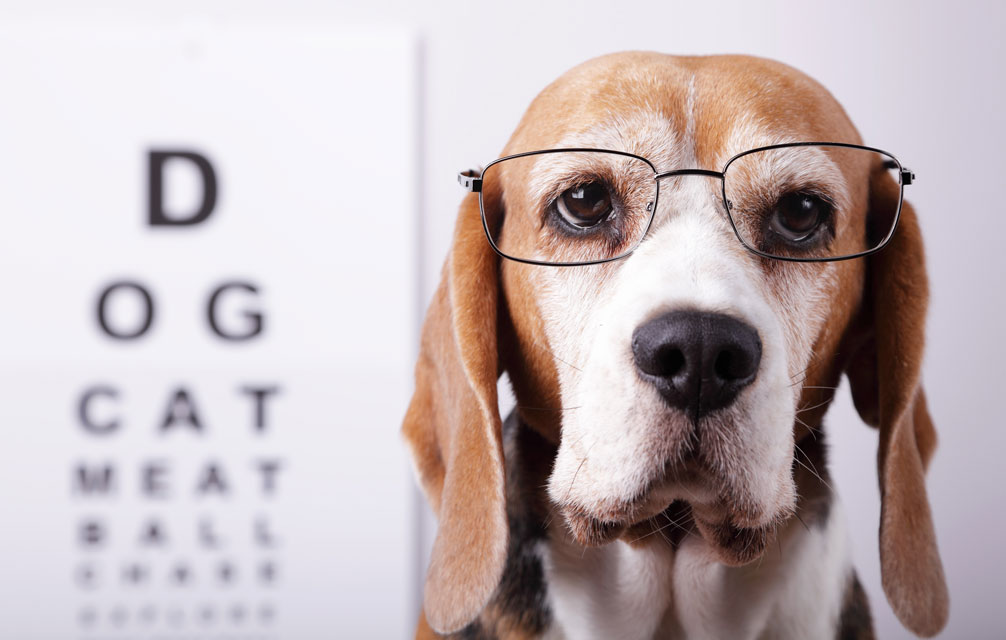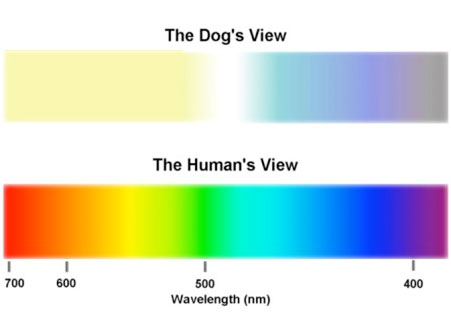Are Dogs Color Blind

For decades, people thought dogs live as though they are in an old black and white movie, unable to distinguish colors. It seems that it must be a ho-hum world indeed. Poor Fido can't even enjoy that handsome winter sweater we so carefully picked out for his days at the dog park. And what about that fancy blue ball he loves to fetch? Is it merely a dim gray orb lolling about in bleak gray grass? Well, not quite.
Can Dogs See Colors?
Until rather recently, the 1990s in fact, it was thought that dogs could not see color at all. After advanced research, science has come to find that a dog's retinas actually do contain the color-sensitive photoreceptors called cones.
So, dogs can see color. However, they have only two types of cones in their retinas, while humans have three. Dogs probably see the world in much the same way as a person who has red-green color-blindness does.
The following graph (courtesy of Dr. Mark Plonsky PHD, University of Wisconson, Stevens Point) is a wonderful and easy-to-read example of how your dog's vision compares to our human vision:

Through this chart, we can see that certain colors are indistinguishable to dogs, and colors look less rich and vibrant to them. Red looks brownish-grey or brownish-black, and orange, green, and yellow all look yellow. Your dog is able to see the color blue, but purple also looks blue. Greenish-blue and green look grey.
More Interesting Information About Dog Vision
Just because we can see more colors than our canine pals doesn't mean that they don't have other advantages in the area of eyesight. This is because, along with cones, dogs' retinas also contains rods, and they have more rod cells than we do. Having more rods allows dogs to see better than us in dim light, have a greater ability to distinguish differing shades of gray, and detect motion better than we can.
Dogs are near-sighted and do not see clearly at distances of more than 20 feet. So, while they are able to detect movement at great distances, they don't have the ability to differentiate between a person and a small tree until they are closer.
References:
- 1. Plonsky, M. (1998). Dr. P's Dog Training - Canine Vision. Retrieved from the web 3/4/2010. http://www.uwsp.edu/PSYCH/dog/LA/DrP4.htm
You May Also Like These Articles:
Why Do Dogs Tilt Their Heads When You Talk?
Why Dogs Like To Roll In Yucky Stuff
Why Do Dogs Eat Poop?: Coprophagia in Dogs
Are Dogs Ticklish? Why Do Dogs Kick Their Leg When You Rub or Scratch Them?
Disclaimer: This website is not intended to replace professional consultation, diagnosis, or treatment by a licensed veterinarian. If you require any veterinary related advice, contact your veterinarian promptly. Information at DogHealth.com is exclusively of a general reference nature. Do not disregard veterinary advice or delay treatment as a result of accessing information at this site. Just Answer is an external service not affiliated with DogHealth.com.
Notice: Ask-a-Vet is an affiliated service for those who wish to speak with a veterinary professional about their pet's specific condition. Initially, a bot will ask questions to determine the general nature of your concern. Then, you will be transferred to a human. There is a charge for the service if you choose to connect to a veterinarian. Ask-a-Vet is not manned by the staff or owners of DogHealth.com, and the advice given should not delay or replace a visit to your veterinarian.



